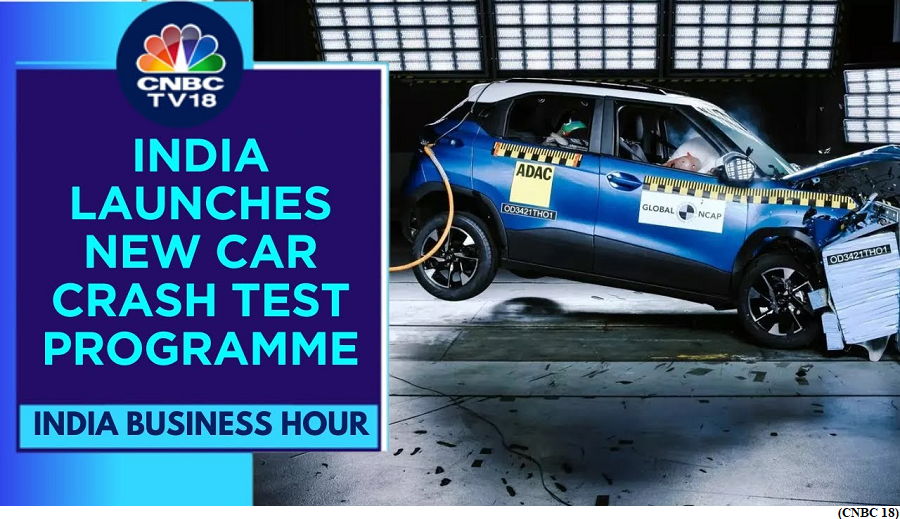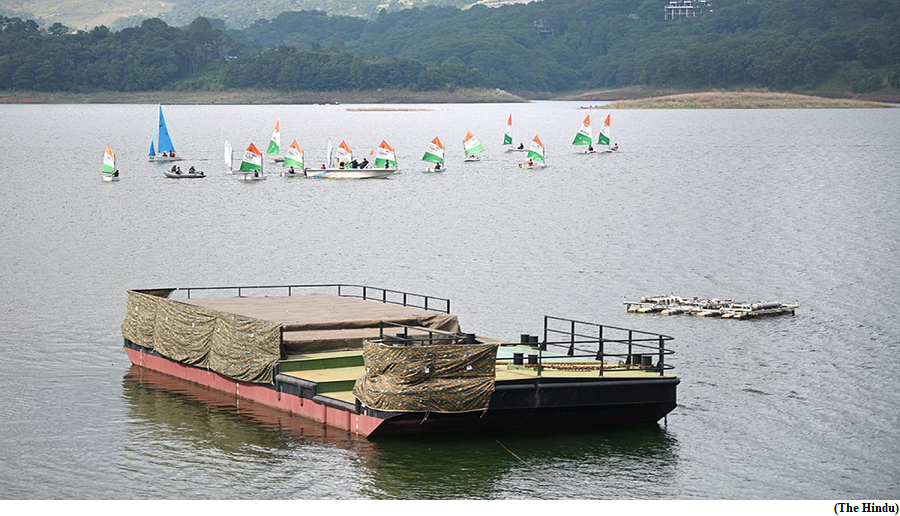Gadkari launches India’s car safety assessment system Bharat NCAP (GS Paper 3, Economy)

Why in news?
- Recently, the Union Minister for Road Transport and Highways launched the Bharat New Car Assessment Programme (NCAP), India’s own crash safety assessment system for new vehicles.
Details:
- It will be rolled out on 1 October, is voluntary and would be similar to international NCAP tests, which seek to evaluate the safety features of a car through multiple crash tests.
- The car taking the new safety test will be rated out of five and the findings of the test will be made public.
What Bharat NCAP tests entail?
- The Bharat NCAP is a voluntary programme and applies to vehicles weighing less than 3.5 tonnes (3,500 kg) and with a capacity of up to eight passengers including the driver.
- The programme allows a consumer to make their decision based on how a vehicle performs under crash tests, and make comparisons.
- Under the programme, a vehicle manufacturer will offer some cars of its preferred model for testing.
- The programme will test vehicles under different scenarios; frontal crash impact, side-crash impact and side-pole crash impact using dummies. A new vehicle will have to be used for each new situation.
Rating:
- The programme will assess safety protocols for adults and children, rating vehicles on the basis of these. For instance, for a 5-star rating for adult safety, a car will be assessed on its anti-locking braking (ABS) system, seat-belt reminders (SBR), pedestrian protection and electronic stability control (ESC), a system that helps prevent the vehicle from skidding.
- For a child, vehicles will need a child restraint system (CRS) to get rated 5-star.
- According to Regulation 44 of the United Nations Economic Commission for Europe, CRS has been classified into categories based on the weight of the child.
- Under this, CRS faces the rear for children weighing up to 13 kg and needs an integrated harness for those up to 18 kg. For those up to 36 kg, meanwhile, the vehicle’s seat belt is used for restraining.
International standards & NCAP:
- Globally, there are nine other NCAPs, with the first programme being launched in the United States in 1978.
- Global NCAP, is a major project of the Towards Zero Foundation, a UK-based charity foundation that promotes safe and sustainable mobility.
- Three car manufacturers in India; Tata Motors, Mahindra and Skoda are in the race to achieve 4- and 5-star ratings for their fleets.
- There is no regulation for electronic stability control (ESC) in India. An ESC is a safety provision that helps prevent a car from skidding while turning, applying brakes or making any such sudden manoeuvres.
On protecting the biodiversity of the northeast
(GS Paper 3, Environment)
Context:
- Fostering tourism, undertaking construction projects and developing infrastructure are ways through which a State generates revenue and creates employment opportunities.
- However, some of them come at a steep environmental cost.

Recent case:
- In the recent case of Re: Cleanliness of Umiam Lake versus State of Meghalaya (2023), the division Bench of Chief Justice Sanjib Banerjee and Justice W. Diengdoh, in its order, stated that “In the absence of any other employment opportunities and in the name of promoting tourism, the natural beauty of the State should not be destroyed”.
- The Meghalaya High Court was hearing a Public Interest Litigation (PIL) on the cleanliness of the Umiam Lake.
- The court in its observation of the Meghalaya Waterbodies (Preservation and Conservation) Guidelines, 2023, said that they did not deal with the “most serious aspect of buildings and construction mushrooming around waterbodies”.
The biodiverse northeast India:
- Northeast India is a green belt region due to its abundant natural resources such as oil, natural gas, minerals and fresh water. The Garo-Khasi-Jaintia hills and the Brahmaputra valley are some of the most important biodiversity hotspots.
- Though the northeast is industrially backward, deforestation, floods, and existing industries are causing serious problems to the environment in the region.
- Both flora and fauna of the areas are under threat due to deforestation, mining, quarrying, shifting cultivation.
Environmental laws:
- Thus far a considerable number of environmental laws and policies have been developed in the country, especially during the 1980s. Offences related to or against the environment have also taken the shape of “public nuisance” under Sections 268 to 290 of the Indian Penal Code (IPC), 1860, dealing with pollution of land, air, and water.
- However, as the Sixth Schedule of the Constitution grants autonomy to District Councils, it limits the authority of the State over matters pertaining to the jurisdiction of the District Councils, including the use of land.
- In many instances, like in the case of the Umiam Lake, the District Councils do not place any regulations for the preservation and protection of land, especially those around waterbodies.
Environmental litigation:
- PILs and judicial activism encouraged under Articles 32 and 226 of the Constitution led to a wave of environmental litigation.
- For example, the National Green Tribunal imposed a fine of ₹100 crore on the Meghalaya State government for failing to curb illegal mining in 2019. It also imposed a fine of ₹200 crore on the Manipur government for improper waste management in 2022.
The pressing priority:
- Central and State governments have to develop infrastructure, generate revenue and create employment through sustainable policies.
Negative List:
- The ‘Negative List’ in the North East Industrial Development Scheme (NEIDS), 2017 is a step in the right direction.
- If an entity is not complying with environment standards; not having applicable environmental clearances; does not have consent from the concerned pollution boards, it will not be eligible for any incentive under the NEIDS and will be put on the ‘negative list’.
Way Forward:
- Similarly, the ‘Act Fast for Northeast’ policy should not only include “trade and commerce” but also the preservation of “environment and ecology” in the region.
- To aim for a 10 trillion-dollar economy, without protecting India’s environment, is a goal not worth pursuing.
- The government should consider the case of creating a uniform environmental legislation, which caters to environmental issues at all levels of governance.
Erratic, deficit rainfall hits breeding cycles of frogs
(GS Paper 3, Environment)
Why in news?
- Erratic and deficit rainfall in monsoon 2023 in the Western Ghats have affected the breeding cycles of amphibians, according to scientists. Animals usually found abundantly in the region during the season have been absent.

Deficient rainfall:
- Coastal Karnataka in the Western Ghats has recorded a 13 per cent deficit in rainfall since June, according to the India Meteorological Department.
- Most parts of Kerala have also seen over 50 per cent of rainfall deficit.
How it impacts breeding of frogs?
- Rainfall results in the formation of temporary rock pools and replenishment of the permanent water bodies where frogs breed.
- However, in the northern Western Ghats, water remains in some pools for only two to three days under short-duration rainfall.
- Frogs lay eggs in this period but they dessicate or dry up before the tadpoles metamorphose into adults, as the pools lose water and moisture essential to complete the breeding cycle.
- Species such as bull frogs, cricket frogs breed during the beginning of monsoon, while night and dancing frogs breed in late monsoons.
- The tadpoles feed on algae, which helps them develop and fully grow. But if the rains are erratic, algae does not form, depriving these tadpoles of their food for growth and development.
- Another species Xanthophryne tigerina or the Amboli toad breeds only for two to three days in a year and lives in lateritic rock, commonly found in tropical regions. If the breeding is disturbed for consecutive years, the population will drop significantly.
Disturbing ecosystem:
- Another factor to consider is that rock pools or water ponds where eggs develop need a certain ecosystem.
- Though temporary, these ponds have a certain pH level of water, have optimum temperatures, life-supporting oxygen and other parameters ideal for eggs to hatch and eventually for tadpoles to survive. If the rainfall stops for a long period, the water remains stagnant, changing all the above mentioned parameters.
- Even a slight rise in temperature and polluting of water can impact the survival of these small creatures.
- Animals like birds and reptiles that prey on frogs will get affected directly if the life cycle of frogs gets disturbed. Such food chain links will be broken in the long run.




